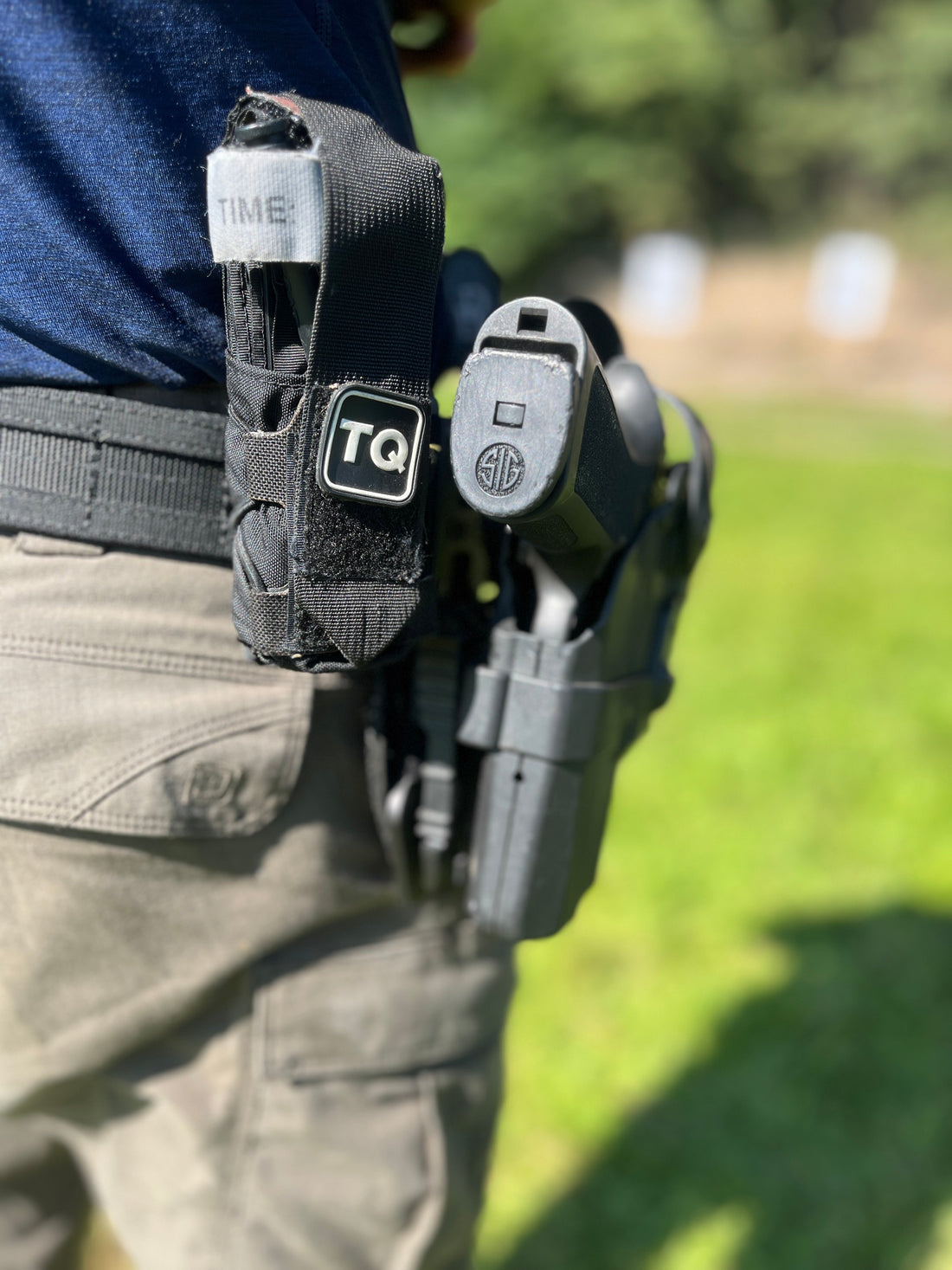
From Holster to Target
Share
From Holster to Target: Sequencing the Draw Stroke for Real World Success
The ability to draw a pistol from a holster must be developed to the level of automaticity (unconsciously or reflexively) to ensure success during critical moments. This skill should be trained as a serial process, involving a series of discrete movements performed in a specific sequence. Proper sequencing minimizes both physical and mental effort, allowing for consistent and repeatable execution under pressure. Additionally, understanding holster retention is essential. Retention levels, ranging from Level I to Level III (Safariland Standards), are designed to prevent unauthorized access and secure the weapon in dynamic environments. Defeating these retention mechanisms is a critical sub-skill of the draw stroke and must be practiced as a structured, deliberate process. Officers must be able to locate their firearm and systematically engage or disengage the appropriate retention features during the draw.
Step-by-Step Process for Defeating Retention in a Safariland Level III Holster
1) Locate your Landmark-Establish a consistent reference point before gripping the pistol
2) Engage the Self-Locking System (SLS)
- Use the firing hand thumb to press down and forward on the SLS strap.
- Simultaneously apply pressure high into the grip tang
3) Disengage the Automatic Locking System (ALS)
- Extend the firing hand thumb and rock the ALS mechanism backward
- Ensure proper hand positioning to maintain a secure grip
4) Prepare for the Draw Stroke
- Keep the firing hand thumb extended and pointed upward to allow for the support hand’s introduction.
- Apply appropriate grip pressure and wrist tension to facilitate a smooth draw.
Common Errors and Their Impact
Improper sequencing of retention defeat can lead to a poor grip, negatively affecting marksmanship.
Excessive movement (head lowering, torso twisting) introduces inefficiencies and disrupts sight alignment.
Bypassing proper retention defeat steps (e.g., pre-lowering the SLS hood) may cause a delay when drawing under pressure.
Shifting attention from the target to the holster disrupts focus and slows reaction time in high-stress situations.
Training Considerations for Automaticity and Skill Retention
Officers should train the draw stroke in progressively dynamic environments (e.g., moving, confined spaces, vehicle extractions).Defeating retention should become an unconscious process to allow cognitive resources to focus on external threats
Distributed practice (shorter, frequent training sessions throughout the year) improves skill retention.
Interleaving training (mixing draw stroke practice with decision-making and perceptual-motor drills) enhances adaptability under stress.
This structured approach ensures officers develop a consistent, efficient, and reliable draw stroke, reducing the likelihood of errors in high-pressure situations.
Importance of Automaticity in the Draw Stroke
In law enforcement operations and the level of skill needed for effective weapon handling in combat shooting (Firearms Training Unit Federal Bureau of Investigation, 2018), drawing a pistol from a holster to the level of automaticity is crucial for success in critical incidents. It’s important for instructors to train the draw stroke as a group of discrete skills strung together, in order, as part of a more complicated skilled action, known as a serial skill (Schmidt & Lee, 2020). The beginning of this action requires that an individual locate the pistol on their person and begin to defeat the levels of retention. Retention is the level of security that a holster provides in preventing the firearm from easily falling out or being drawn by another person other than the individual wearing the holster. Defeating active retention in a level I through III pistol holster is a specific motor skill that can be considered a subset of the draw stroke as a whole. The levels of active retention present a number of sequencing challenges, making order critical for optimal performance. Ultimately, the goal is to be able to perform the draw stroke and present the firearm with maximum certainty, while minimizing physical and mental energy and time needed to do so (Schmidt & Lee, 2020). In other words, the goal is to set the stage for a repeatable and consistent draw stroke under pressure.
After initially training the draw stroke to some level of proficiency in a stable and predictable environment, research has shown that in order to maintain retention of the skill with a high degree of transferability, presents additional factors, including body transport and the ability to defeat holster retention while in motion, as well as the officer’s ability to interact with the firearm and holster simultaneously. Additionally, a number of environmental factors, such as motor vehicles and confined spaces, could impact the likelihood of executing these skills on demand with maximum certainty in high-stress situations.
The initial steps in defeating retention are the first in a series that can be categorized as a serial skill. For example, an instructional technique using a Safariland level III-style holster involves first finding a familiar landmark on the firearm before initiating a grip. After locating the landmark, the process to defeat the holster retention involves three distinct movements of the thumb. The first step, after finding the landmark, is to use your firing hand thumb to press down and forward on the Self-Locking System (SLS) strap while simultaneously pressing your firing hand down and high into the area of the grip commonly known as the “tang.” The firing hand thumb, which should now be at full extension, is then used to rock the automatic locking system (ALS) backwards. Careful attention must be given to the portion of the thumb that is used to press the ALS backwards, so as to not create a gap between the “meaty” portion of your hand and the top of the grip module closest to the slide. Depending on the size of the individual's hand and the circumference of the grip module, finding this portion of the thumb used to actuate the ALS may vary. The final step before beginning to draw the pistol in an upward motion is the position of the firing hand thumb. If left at extension, the firing hand thumb should be high and pointed upwards to allow for the introduction of the support hand later in the draw stroke. At this point, specific grip pressure by the firing hand on the grip module and wrist tension are set, allowing for the successful progression of the remainder of the draw stroke. The above steps are transferable to either left or right-handed shooters.
We’ve noticed that failure to follow the proper sequencing in just defeating retention often results in a poor grip and, consequently, poor marksmanship, most notably during successive rounds. To achieve maximum efficiency, excessive and unnecessary movement, such as lowering the head and twisting the torso, should be avoided, as this ultimately leads to other issues later in the draw stroke while bringing the sighting system into alignment. The likelihood of performing this skill with maximum certainty is also reduced when a portion of this sequence is missed. An example of this would be when an officer inadvertently or intentionally lowers the SLS hood in order to “make it easier” to remove the firearm from the holster. However, when under pressure (most commonly during force-on-force training or when introduced to time constraints), there will be a perceptible delay. In this case, the officer will typically move to defeat the SLS mechanism as described above, but the hood has already been rotated down and forward, sometimes resulting in a perceptible delay when drawing the firearm from the holster. Anecdotally, the delay appears to possibly be a result of the officer’s shift from external to internal focus. The officer initially focused on a target or threat while conducting a process they had trained for repeatedly (defeating the first level of retention); however, that critical portion of the sequence was missing. When this occurs, it appears as if the officer briefly shifts their attention from the target of focus and back to the task of defeating the holster retention system.
After the decision has been made to draw, the process of defeating retention needs to be performed without conscious thought to allow attentional resources to be directed at external threats. As trainers, the categorization of this skill as serial should be recognized due to the sequential number of discrete skills that need to be performed. To assist in developing this skill to automaticity, research has shown that trainers could space the training in smaller blocks of training throughout the year and/or interleave with other perceptual-motor skills and decision making scenarios.
References:
